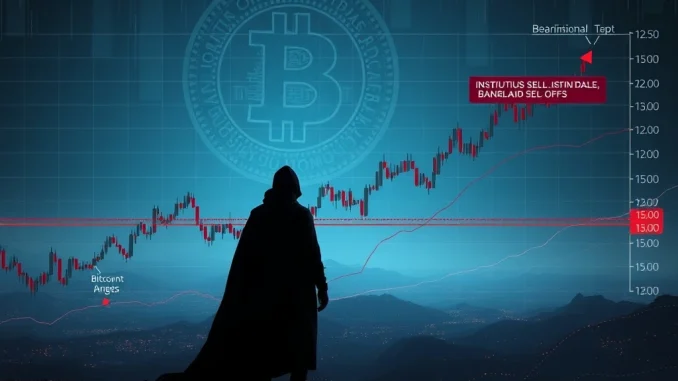
The cryptocurrency world is abuzz as Bitcoin finds itself in a tight embrace, oscillating between the critical $116,000 and $118,000 marks. This period of Bitcoin consolidation has traders on edge, eager for a definitive breakout amidst palpable market uncertainty. What’s driving this indecision, and what does it mean for the broader crypto market? Let’s dive into the recent developments, from major institutional moves to subtle shifts in investor sentiment.
Understanding Bitcoin Consolidation: What Does It Mean for Your Portfolio?
For the past two weeks, Bitcoin has been locked in a defined trading range, repeatedly retesting mid-range levels where the majority of trading volume has occurred. This isn’t just a lull; it’s a strategic tug-of-war between bullish and bearish forces. While some see renewed buying interest as a sign of underlying strength, others interpret the lack of directional momentum as a clear indicator of broader market indecision.
Think of it as a crucial battleground. The $116,000 to $118,000 zone represents a point of equilibrium where neither buyers nor sellers have managed to seize firm control. This Bitcoin consolidation phase often precedes a significant price move, making it a period of intense observation for savvy traders. The question isn’t if it will break out, but when, and in which direction.
The Unsettling Impact of Galaxy Digital Selloff on BTC Price Action
A significant factor contributing to Bitcoin’s current sideways movement is the recent Galaxy Digital selloff. This major institutional player transferred nearly 30,000 BTC, valued at an astonishing $1.15 billion, to centralized exchanges and over-the-counter (OTC) desks. This move immediately triggered concerns across the market about potential follow-on liquidation, adding a layer of volatility to an already sensitive environment.
Here’s why the Galaxy Digital selloff is so impactful:
- Supply Shock: Moving such a large volume of Bitcoin to exchanges increases the available supply for sale, potentially putting downward pressure on prices.
- Sentiment Shift: Large institutional outflows can signal a lack of conviction from major holders, influencing retail investor sentiment negatively.
- Liquidity Concerns: While OTC desks absorb some of this, the sheer volume can strain market liquidity, leading to sharper price reactions.
This event has undoubtedly influenced recent BTC price action, contributing to the choppy conditions and false breakouts we’ve observed.
Are Bearish Signals Dominating the Crypto Market Outlook?
Adding to the cautious sentiment, blockchain analysts have identified a rising wedge pattern in Bitcoin’s price chart. This technical formation is widely considered a bearish signal, especially if the $110,000 threshold is breached. A break below this level could accelerate downward momentum, leading to further price corrections.
However, the narrative isn’t entirely one-sided. On-chain data provides a counterpoint: large holders appear reluctant to offload their assets, with active supply stabilizing within the $117,000–$123,000 range. This suggests that retail selling pressure has yet to intensify, potentially offering a near-term floor for Bitcoin’s price. It’s a classic battle between technical indicators suggesting caution and on-chain data hinting at underlying strength.
The confluence of these factors creates a complex picture for the overall crypto market. While some indicators flash red, the absence of widespread panic selling among long-term holders offers a glimmer of hope.
Navigating Market Uncertainty: What’s Next for Bitcoin?
Beyond the immediate market dynamics, broader macroeconomic factors are playing a significant role in fostering market uncertainty. Global trade tensions, coupled with delayed U.S. fiscal policy developments, have contributed to a cautious investor stance across all asset classes, including cryptocurrencies. This external pressure further dampens trading momentum and makes decisive moves harder to come by.
Valentin Fournier of BRN suggests that the current pullback could serve as a “healthy reset” after a period of aggressive long positions. However, he also warns that further declines towards $110,000 remain a risk if bullish momentum fails to recover. Dean Chen of Bitunix echoes this sentiment, characterizing the current phase as “consolidation rather than a bear market,” implying that structural support for Bitcoin remains largely intact for now.
For investors, patience is key. A decisive close above $120,000 could reignite bullish momentum, while a breakdown below $116,000 may trigger further downward pressure. Monitoring volume and price action around these mid-range levels will be crucial for understanding Bitcoin’s next move. The Index Bitcoin Cycle Indicators (IBCI) entering a distribution zone also signals potential market tops, urging traders to adopt a patient strategy and avoid premature entries.
Beyond Bitcoin: How Are Altcoins Faring in the Current Crypto Market?
Bitcoin’s struggles often ripple through the wider crypto market, and this period of consolidation is no exception. Ethereum (ETH) and other prominent altcoins like XRP and Solana (SOL) have experienced single-digit losses, mirroring Bitcoin’s indecision.
However, there are nuances:
- Ethereum’s Resilience: ETH has managed to find partial support above key levels, demonstrating relative strength compared to smaller tokens. This suggests a more robust underlying demand for Ethereum despite the broader market’s struggles.
- Smaller Altcoin Vulnerability: Many smaller altcoins are facing renewed selling pressure, indicating that capital might be flowing out of riskier assets and consolidating into more established cryptocurrencies or even out of the market entirely.
The performance of altcoins will largely depend on Bitcoin’s ability to break out of its current range. A bullish move from BTC could provide the necessary tailwind for altcoins to recover, while a breakdown could exacerbate their losses.
Conclusion: Navigating the Choppy Waters
Bitcoin’s current Bitcoin consolidation phase between $116,000 and $118,000 is a critical juncture. The significant Galaxy Digital selloff has undoubtedly introduced bearish signals and heightened market uncertainty, influencing BTC price action and the broader crypto market. While technical indicators suggest caution, on-chain data points to underlying resilience from large holders.
The coming days and weeks will be crucial. Investors should closely monitor key price levels, institutional activity, and global macroeconomic developments. As the market awaits a major catalyst, a patient and informed approach will be your best strategy to navigate these choppy waters.
Frequently Asked Questions (FAQs)
1. What does Bitcoin consolidation mean for its price?
Bitcoin consolidation refers to a period where its price trades within a narrow, defined range without a clear directional trend. It signifies a balance between buying and selling pressure, often preceding a significant price move either upwards or downwards once a breakout or breakdown occurs.
2. How did Galaxy Digital’s selloff impact Bitcoin’s market?
Galaxy Digital’s transfer of nearly 30,000 BTC to exchanges and OTC desks injected a large volume of supply into the market. This move sparked concerns about potential liquidation, contributing to increased market volatility, dampened trading momentum, and the current sideways price action, acting as a bearish signal.
3. What are the key bearish signals for Bitcoin currently?
One prominent bearish signal is the identification of a rising wedge pattern in Bitcoin’s price chart. If Bitcoin breaches the $110,000 threshold, this technical pattern suggests a potential for further downside. Additionally, slowing ETF inflows and broader macroeconomic uncertainty contribute to the cautious sentiment.
4. How are altcoins performing during this Bitcoin consolidation phase?
The broader crypto market, including altcoins like Ethereum, XRP, and Solana, has largely mirrored Bitcoin’s struggles, experiencing single-digit losses. While Ethereum has shown some resilience by holding key support levels, smaller altcoins are facing renewed selling pressure, indicating a flight to safety or out of the market.
5. What are the critical price levels to watch for Bitcoin’s next move?
Traders should closely monitor the $116,000 and $118,000 range. A decisive close above $120,000 could reignite bullish momentum, while a breakdown below $116,000 may trigger further downward pressure towards the $110,000 mark. These levels will likely dictate Bitcoin’s short-term direction.



